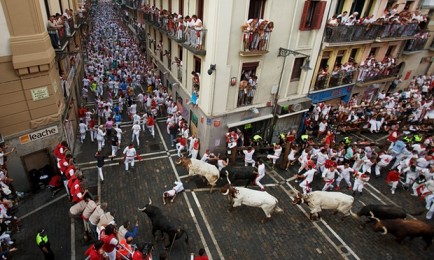
The Pamplona bull run, pictured here, is perhaps the most famous of all of Spain’s bull run festivals.
It’s been an abnormally bloody summer for Spain’s various bull-run festivals. Each year, like clockwork, reports of the first casualty – usually an inebriated American tourist – roll in, followed by perhaps one or two more.
Cue the usual hang-wringing about the danger and cruelty of it all, only for the same events to play out like clockwork the next year. But this year has been different. Very different…
So far this summer there have been 10 deaths by goring on the streets of Spain and, save for some mysterious revenge uprising organised by the bulls, experts are at odds over what has caused this upsurge in deaths.
One theory is that the hotter weather – July has been the warmest on record in Spain – has made the bulls more agitated than normal, and the attendant human ‘runners’ more sluggish, thereby leading to more incidents.
Another, perhaps more accurate theory, is to blame this rise in deaths on the fact that the economic crisis and a slowly shifting attitude towards bullfighting has cut the number of registered bullfights in the country by 300 a year.
However, despite fewer registered bullfight events, ranchers are still raising the same number of fighting bulls – bulls with pent-up aggression and nowhere to go… except, maybe, to the streets of Spain.
El Pais bullfighting critic Antonio Lorca certainly believes this is the cause of the “abnormally high” number of deaths.
“The only way out for these ranchers would be in the festival in these municipalities,” said Lorca. “It suggests that many of the bulls that would have been destined for bullfights are instead running along the streets of this country.”
There is no legal stipulation that states certain bulls must be used for the running festivals, but ordinarily the largest and most aggressive beasts are held back for performance in the bullring. But with fewer fights, the theory goes that these fiercer animals are now being let loose on unsuspecting festival-goers.
“These are bulls with more power, more capacity to charge,” said Lorca. “An encounter with one of these would likely do more harm than the bulls of previous years.”
With ten deaths so far – mostly from goring as people have failed to get out of the way in time – the evidence is stark. There have been more bull runs this year, up 16 per cent on 2014, but that can still not explain this uptick in fatalities.
One interesting theory doing the rounds – ironically on social media platforms such as Facebook and Twitter – is that the rise of the social media-enabled smartphone has exacerbated the problem.
As people try to document their ‘once in a lifetime’ experience by posing for a selfie or taking a video, many are – quite literally – taking their eye off the bull. Such behaviour was graphically captured on film last week in the town of Villaseca de la Sagra, when a 32-year-old man documented his own goring while trying to film the bull run. He did not pay proper attention to the bull coming his way, and was fatally wounded in the neck.
The same thing happened to a 44-year-old Frenchman in Pedreguer, who was so engrossed in filming the event that he was unaware of the bull charging towards him.
A couple of sad but ultimately avoidable deaths. Whatever the cause of this upsurge in fatalities, the bulls are really not to blame.
 en
en



 Vlaams-Nederlands
Vlaams-Nederlands
1 Comment
Leave a Comment
DISCLAIMER
The opinions and comments expressed by contributors to this Blog are theirs alone and do not necessarily reflect the views of VIVA Homes Under the Sun Ltd, any of its associated companies, or employees; nor is VIVA to be held responsible or accountable for the accuracy of any of the information supplied.
James LawlessAugust 27, 2015 at 1:27 pm
El toro, aun la vaca, son animales peligrosos.
Have you got something to say?